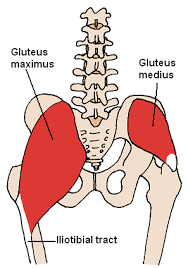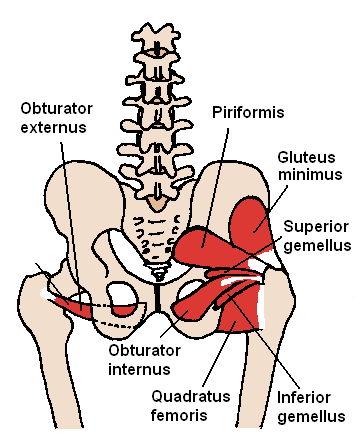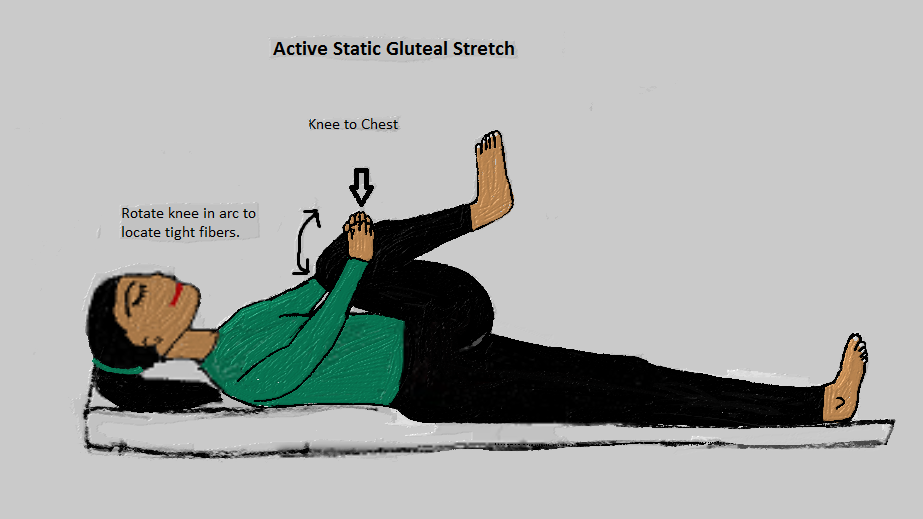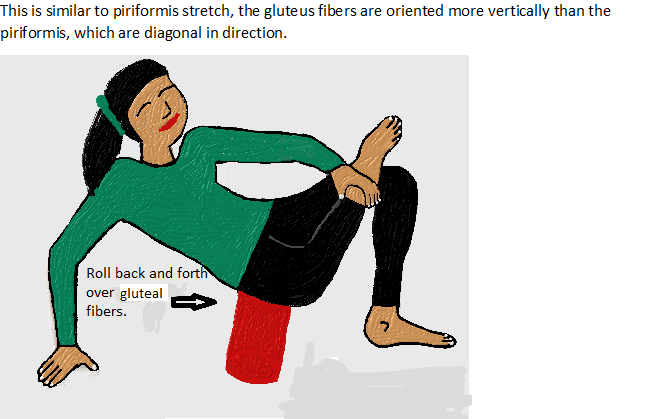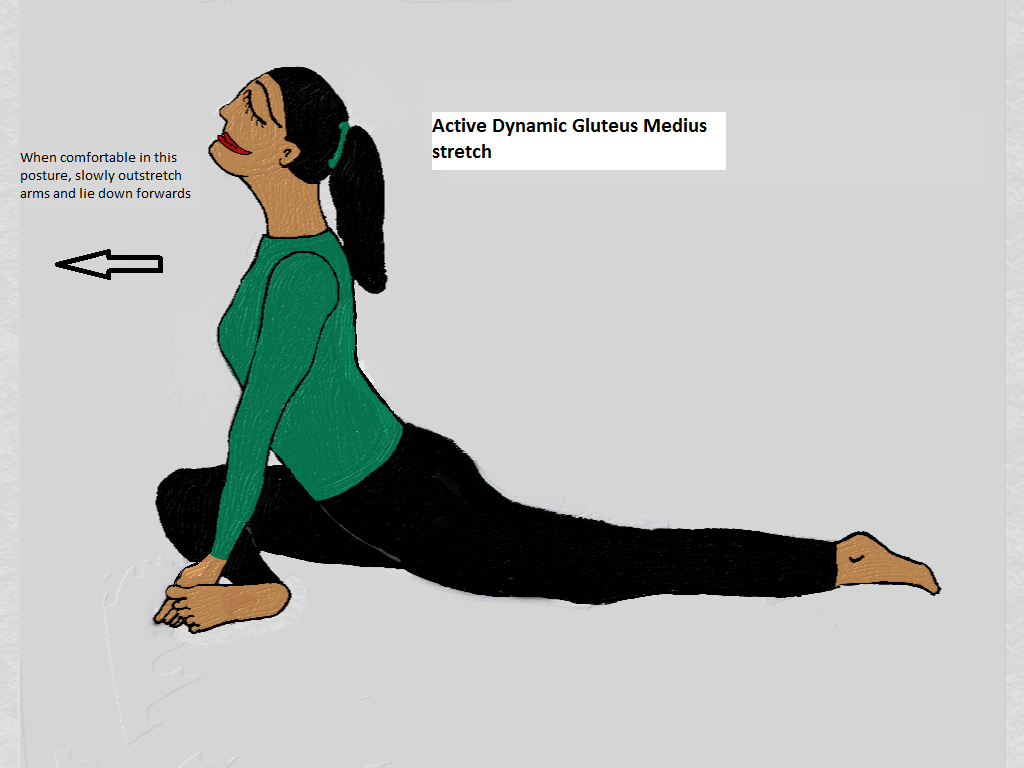|
Last week was a deviation from the stretch posts and diving into yoga in healthy living.
Getting back to the lower extremity stretches, gluteal stretch is the last in the series. There are three gluteal muscles, the deepest being the gluteus minimus, next the gluteus medius and gluteal maximus being the most superficial muscle. • The gluteus maximus originates from the posterior gluteal line (on ilium), the iliac crest, the sacrum, coccyx, the sacrotuberous ligament, and lumbodorsal fascia. It inserts in two parts: • i) majority of fibers insert into the iliotibial band after passing over the greater trochanter (here it is protected by a bursa between the tendon and bone), ii) the rest of the fibers insert into the gluteal tuberosity on the femur. • The gluteus medius originates between the anterior and posterior gluteal lines on the ilium and completely covers the deeper gluteus minimus. It inserts into the greater trochanter of femur. • The gluteus minimus originates between the anterior and inferior gluteal lines on the ilium and inserts with the gluteus medius on the greater trochanter of femur. The gluteus maximus and hamstrings are the major hip extensors. The gluteus maximus being a one-joint muscle, functions only as extensor at the hip joint. The gluteus medius is an important hip abductor, especially during walking, as it prevents the pelvis from dipping when the contralateral leg is in swing phase. Since the gluteal muscles are fan-shaped covering a wide area, stretching them is not done in one fixed position, albeit it varies from person to person, and also the same individual may experience stretch at more than one angle. It is good to explore the span of the muscle and stretch as tightness is encountered. Here are ways to stretch the gluteal muscles. These are similar to piriformis stretches. As always we will consider right sided stretch for ease of understanding. However it is good to stretch muscles bilaterally (both sides). Passive Stretch: This is done on the mat in supine position, with the left leg in neutral. The therapist flexes the right hip and knee to end range of motion. Hip flexion is limited by approximation/contact of soft tissue and has a soft- tissue like springy end-feel. The span of muscle is stretched by rotating the right knee from pointing to left shoulder and gradually aligning with hip joint to pointing outwards in an arc. When a stretch is experienced, the position is held between 5-30 seconds for as long as possible. Active Static Stretch: This can be done in supine with the individual flexing the right hip and knee to end range of motion. Circle the thigh/leg with both arms and pulling the leg towards the chest/abdomen. Move the right knee in an arc from pointing at left shoulder, to pointing caudally (towards head), and finally, outwards. Hold the position between 5-30 seconds, for as long as possible. Active Dynamic Stretch: i) The pigeon pose or kapotasana: You begin from the plank pose and bring the right foot onto the floor in front of the left hip joint. Bring your foot and toes up while sticking out the ball of right foot and push the outside of foot onto the mat. Bring the right knee to the floor. The hip may be abducted so that the knee is slightly lateral to the hip and slowly scoot the left leg back and rest the top of foot onto the mat, ensuring the left hip is in line with the left foot at all times and the body weight is centered. The forearms here will rest on the mat as you continue slowly scooting the left foot back and elongating the body. When you feel a stretch in the right buttock area, stay there for a while. Deepen the stretch when possible by lowering the trunk to the floor and outstretching the arms in front during exhalation. ii) Ardh Matsyendrasana: This asana is done on the floor or on a mat in seated position. Begin in cross-legged seated position. Bring the right foot next to the left thigh, just above the left knee, so that thigh and leg is upright and the right knee is pointing toward ceiling. Reach overhead with the left hand and elongate the spine while bringing torso close to the right thigh. With the left arm reach across the right knee, pushing the right thigh across midline, into hip adduction and if possible, bring a left flat palm onto the floor by hooking it under the left knee. The left arm is externally rotated and supinated to achieve this position. Next, turn the trunk to the right bringing the right hand to the floor behind the torso for spinal rotation to right. Hold the position for few seconds. Release asana by bringing spine to neutral rotation, unhooking the left hand and bringing right leg back to cross-legged sitting position. Stretching with tools equipment: i) Foam roller stretch: This is similar to piriformis stretch, except that the gluteus fibers are oriented more vertically than the piriformis, which are diagonal in direction. For effective stretch, it helps to orient the foam roller perpendicular to the direction of muscle fibers. Place the foam roller on the mat and sit on it. Bend both the knees with feet flat in front on the mat. Bring both palms on mat, behind the roller and shift your weight onto the arms. Lift the right foot off the mat and bring it onto the left thigh, right ankle resting just below the left knee. Make a quarter turn to half a turn to the right side and gently roll the foam roller under the right buttock. You can release different segments of the muscle by rolling further onto right side in small increments. Base the body weight you put onto foam roller by the intensity of release experienced.
0 Comments
Your comment will be posted after it is approved.
Leave a Reply. |
Details
AuthorAmi Gandhi is a licensed physical therapist in the state of California. She is the owner of StableMovement Physical Therapy, a small boutique practice in San Jose that offers patient centered, one-on-one, hands-on physical therapy. Archives
March 2018
Categories |
